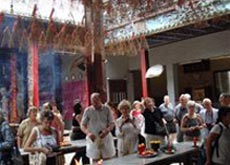Ho Chi Minh City is one of the most desirable destinations in Vietnam, having attracted thousands of visitors and immigrants who bring with them their own customs, mores and beliefs.

The city features a number of impressive buildings reflecting this blend of Vietnamese, Chinese and European cultures. One example is Cho Lon in HCMC’s District 5, also known as Chinatown, where the Lady Thien Hau Temple is a popular venue for worship by the Chinese community.
As such, the Lady Thien Hau Temple is a worthwhile stop on any tour of Chinatown in HCMC. At this temple visitors can learn more about the confluence of the Taoist, Confucian and Buddhist religions, and how they relate to the moral values of present daily life.
The temple, located at 710 Nguyen Trai Street in District 5, was built in 1760 in typical Chinese architectural style by a group of Chinese from Guangdong, Guangzhou and Fujian. It was restored in the 1800s and again in 1916. The inner temple is for worship and the outer area is for sacrifices.
The temple commemorates Lady Thien Hau, the Goddess of the Sea, who was born in China on the 23rd of the third lunar month in AD 940, and passed away in the 9th of the ninth lunar month. Legend tells that in her sleep her spirit flew to the sea and at the sight of endangered sinking vessels the goddess flew to the sailors and saved them. She was thus worshipped as the protector of the Chinese fishermen.
Later, in the 17th century during the mass evacuation of Chinese from mainland China to Vietnam the Chinese prayed to Thien Hau for her magic power to guide them and upon safe landing they collected money and gold to build temples dedicated to her to thank her for her protection. One temple is in Hoi An and the other is the temple in Cho Lon, HCMC. The temples tell stories about gratitude.
After viewing the main chamber where the statues of Lady Thien Hau, her mother and her sister are seated, one can look up and see spiral incense hanging on the ceiling. To show respect, an old man beats the drum every time a donation is made as recognition of a good deed. This custom was brought to the temple by Taoists.
The figurines on the walls of the temple decorated with turquoise tile pieces are evidence of how the Chinese pay tribute to great men. They represent national heroes, a king, a scholar or mandarin, the temple’s founders, an old man, a rich person and a wood cutter.
The Chinese and Vietnamese have long practiced indiscriminate worshipping. Little time and energy is spent differentiating which is Buddhist and which is Taoist. Meanwhile, the influence of Confucianism is reflected in the philosophy of the five moral teachings, Righteousness, Benevolence, Courtesy, Wisdom and Faithfulness, which are still performed in their ways of living.
In other words, worshippers here pay their respect to the gods and goddesses, lead a good life and accumulate fortune for the future and for their children’s heritage.
The annual Lady Thien Hau Temple festival is on the 23rd day of the third lunar month on the occasion of the Lady’s birthday anniversary. The festival attracts both Vietnamese and Chinese Buddhists to raise their prayers to the Lady.